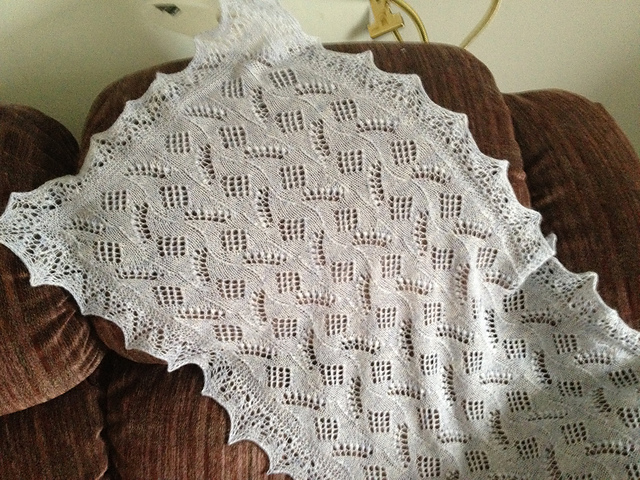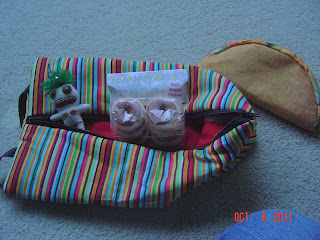I finished up a modular pillow for a class that occurred yesterday. It is knit center out from
Noro Taiyo using
Emily Ocker's cast on. It was a good refresher for me as I haven't used that cast on in years. I enjoyed seeing the colors develop but the knitting was hard on my hands. The cotton/silk in Taiyo was unforgiving and inelastic. But the end result is pretty. I made it reversible but not identical. If you are feeling warm and fuzzy, you can use the warm side.

Or, you can embrace your cool side by flipping the pillow over.

I went to a spinning workshop with
Judith McKenzie right after Rhinebeck. It was truly amazing. The workshop was set up by
Hansencrafts, specifically focused on the mini-spinner. Beth and Kevin Hansen are great hosts. They had arranged for everything - snacks, coffee, goodie bags and plenty of camaraderie along with the learning.
On the first day, we learned to adjust the mini-spinner so we could spin yarns of different diameters. It was a different way of thinking about diameter. On the one hand, you can control how much fiber you are drafting to change the diameter. Judith's view is that we all have a natural way of drafting and eventually we'll revert to that. So she believes in setting up the wheel to help draft the desired diameter. All I can say is that it works. Here's my ring of samples from thin on the right to thick on the left. Each is plied back on itself so they are all comparable. Can you believe I spun the laceweight on the far right?

We also learned to spin thick and thin yarn. Here's my flame yarn sample. Not great but definitely thick and thin. Flame yarn is thick and thin yarn plied back on itself.

After that we spun a variety of fibers. In this picture of the leftover fibers, we have (clockwise starting at the top left) cashmere, bombyx (cultivated) silk, yak/silk, a silk hankie (from the goodie bag, I didn't spin this although Judith demonstrated how to), tussah (wild) silk, light and dark BFL, cashmere and cotton. Yes, I spun cotton using long draw. It was fun. I didn't get enough twist into it because some of it fell apart when I wound it off the bobbin. But I have more to practice with. I made little 2 ply samples of these and put them in a folder.

We also spun silk noil using long draw and I tried carding some of it. I have some samples but I didn't like spinning it. Bits of cocoon and insect parts fly off in all directions and it is impossible to pick all of it out. I found it messy and a bit off-putting.
Judith gave us some dyed mohair locks to try spinning boucle. I am afraid that I failed miserably. My boucle yarn is coming apart. I used some Habu silk as the core. But then, as we left, Judith explained what I was doing wrong. I have to practice a little with these locks to see if I get it. You have to grab the fiber with the hand holding the core and then slowly release it from the hand holding the locks. I was just holding it close to the core thinking the twist would grab it.

We spent a lot of time discussing how to
spin for color. Judith gave us samples of color (I took some more later as she wanted us to take the extra fiber to avoid having to cart it back) and we practiced holding 3 colors (A, B, C) in parallel and spinning across all of them. You get color A, color AB, color B, color BC and then color C. After you go back and forth across these a few times, you switch out A for D and continue spinning across B, C, D. Then you switch out B for E a while later. Then A comes back in when C is removed and so on. You spin the next single the same way if you want the colors to line up in self-striping units. Or you can cable the 2 plies together to get a lovely yarn that has spots of color sprinkled all the way through. This one is a test of pure worsted spinning which I have to work on. You don't get the pure color and the dense yarn you need for socks without spinning worsted.


Our goodie bags had lots of things - pins from
Zippypins, who was in the class with us, the silk hankie, a clip with beads to help hold the yarn end when taking a break, and some
Potluck roving from Ferndale Fiber. I got some Paradise (the green/blue below) in my goodie bag. Later we had a random drawing to select another ball and I picked Paradise again. Lastly, at the end of the workshop, there was still more fiber and we got to pick again. This time I got Stormy Seas. Thank you Ferndale Fiber!

All in all, I loved every minute of the workshop. I came away with a lot of ideas on how to spin and now I need to practice all the various techniques I learned. If you get the opportunity to take a class with Judith, jump at it. She is a wonderful teacher!






























 Or, you can embrace your cool side by flipping the pillow over.
Or, you can embrace your cool side by flipping the pillow over.
 We also learned to spin thick and thin yarn. Here's my flame yarn sample. Not great but definitely thick and thin. Flame yarn is thick and thin yarn plied back on itself.
We also learned to spin thick and thin yarn. Here's my flame yarn sample. Not great but definitely thick and thin. Flame yarn is thick and thin yarn plied back on itself. After that we spun a variety of fibers. In this picture of the leftover fibers, we have (clockwise starting at the top left) cashmere, bombyx (cultivated) silk, yak/silk, a silk hankie (from the goodie bag, I didn't spin this although Judith demonstrated how to), tussah (wild) silk, light and dark BFL, cashmere and cotton. Yes, I spun cotton using long draw. It was fun. I didn't get enough twist into it because some of it fell apart when I wound it off the bobbin. But I have more to practice with. I made little 2 ply samples of these and put them in a folder.
After that we spun a variety of fibers. In this picture of the leftover fibers, we have (clockwise starting at the top left) cashmere, bombyx (cultivated) silk, yak/silk, a silk hankie (from the goodie bag, I didn't spin this although Judith demonstrated how to), tussah (wild) silk, light and dark BFL, cashmere and cotton. Yes, I spun cotton using long draw. It was fun. I didn't get enough twist into it because some of it fell apart when I wound it off the bobbin. But I have more to practice with. I made little 2 ply samples of these and put them in a folder.















